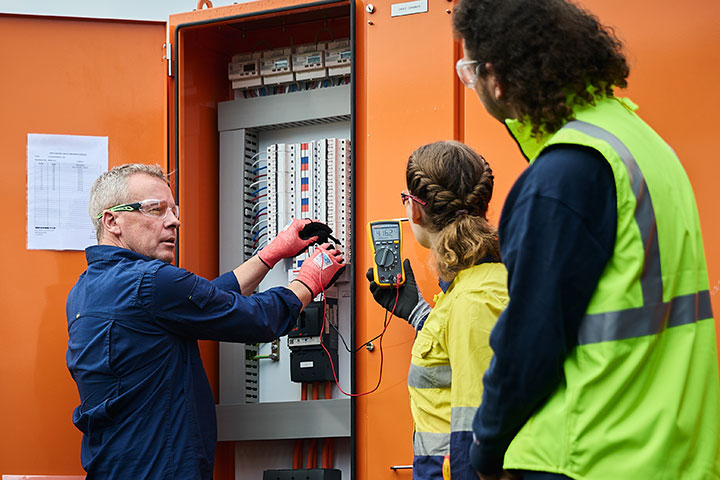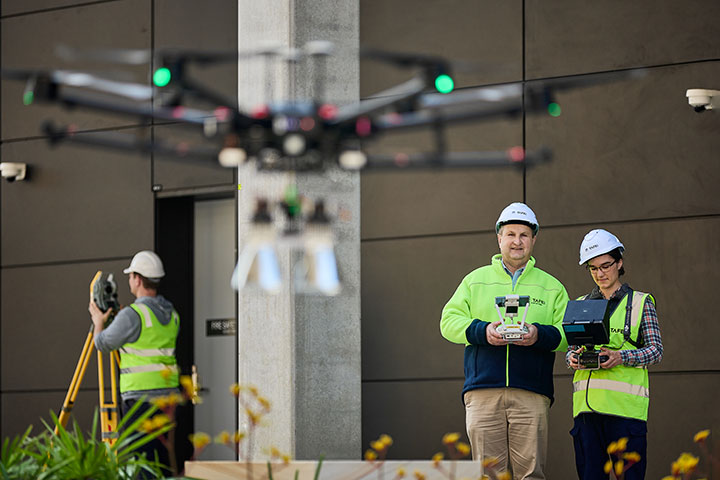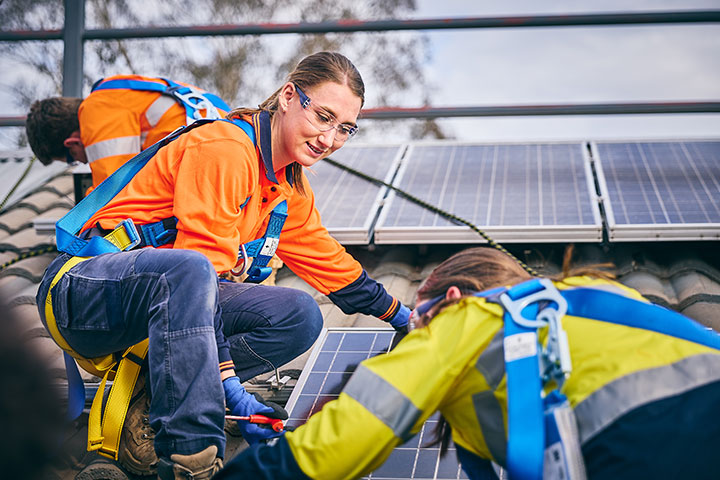Renewable Energy Courses at TAFE NSW
Our energy sector is undergoing a transformation – with battery storage, hydroelectricity, hydrogen, solar and wind energy all playing a critical role in paving the way for a net zero emissions future. TAFE NSW offers training to meet the needs of this emerging sector and the demand for skilled labour across a range of industries.
Courses in Renewable Energy

Automotive
Learn what it takes to make the switch from fossil fuels to renewable energy as you work with alternative fuels.

Business
Plan activities, oversee finances, ensure regulatory compliance, and care for employees, customers, and the community as you build a career in the renewable energy sector.

Civil Industry and Construction
Design and construct civil works used by future energy infrastructure, such as dams, structures and pipe networks.

Electrical
Install and maintain vital energy generation assets to switch from carbon-intensive energy sources to renewables.

Engineering
Be part of the drive to develop practical solutions to complex problems and solve future energy challenges.

Maritime
Construct and maintain wind farms in offshore waters.

Surveying
Gather information on the shape of the land to support the construction and layout of future energy infrastructure.

Sustainable Practice
Protect natural resources used by future energy systems.

Transport and Logistics
Learn how to evolve production, storage, inventory, delivery, and distribution modes using renewable energy.
Your pathway to a renewable energy career
Whether you’re considering your future career or looking to upskill and specialise in renewable energy, TAFE NSW has a course for you. Explore our range of microskills and qualifications that will give you the skills that help contribute to a cleaner, brighter future.

Frequently asked questions
Each industry requires a variety of specialist skills to design, construct and maintain. We have a range of courses and supportive learning environments that will help you make the most of your career or study opportunities. Our courses are delivered full time and part time, with options to study in the classroom, online, or blended. Interested in working in a particular sector? Contact TAFE NSW or search for courses.
Click here to find out how to apply and enrol.
Search courses
- Solar Energy is generated by capturing light and heat radiating from the sun. This energy can be converted into electricity or used to heat air or water. The most common conversion of solar energy is into electricity where it can be used to help power the electricity grid. It is common to see solar panels on building roofs, or large collections of solar panels to make up a solar farm.
- With ten operational large-scale wind farms in NSW and more in development, Wind Energy is becoming more common. Wind energy is generated by converting the kinetic (motion) energy of the wind into electricity when the wind rotates wind turbine blades that are connected to a generator. The electricity that is generated can be used to help power the electricity grid or stored in large scale batteries.
- Hydrogen Energy comes from the combustion of hydrogen. The energy from hydrogen combustion can be used to power an internal combustion engine or run an electricity generator to generate electricity. Hydrogen can also be used in fuel cells to generate electricity. The byproduct of hydrogen combustion is water. Hydrogen is the most abundant element in the universe and can be used to store and deliver energy, in a similar way to existing gas networks. Fossil fuels have traditionally been used to create hydrogen gas, but renewable hydrogen is becoming more widely available. Green hydrogen is created from electrolysis of water using renewable electricity. Hydrogen has the advantage of being a carrier of energy, meaning it is easily transported and can be mobile (for example, used in hydrogen powered vehicles. Hydroelectricity relies on the conversion of kinetic (motion) energy in flowing water to turn an electricity generator connected to a turbine. The generated electricity can then be used to power the electricity grid. Pumped hydoelectricity operates in a similar way to hydroelectricity, except the generators can be switched to motors to drive the turbines as pumps and pump water from low to high elevation reservoirs. This is typically done when there is an oversupply of electricity, and the cost of energy is low. Pumped hydoelectricity is sometimes referred to as a battery, as the energy source (high elevation reservoirs) can be recharged by pumping water from low reservoirs to high reservoirs.
- Battery Storage refers to the storage of energy that can be readily converted to electricity. Most batteries store energy using chemicals. Batteries are a critical component of renewable energy as they can store excess energy for long periods of time and then deliver the energy to the electricity grid.
Sustainable energy touches every industry, have a look below for what sort of jobs TAFE NSW is skilling the workforce of the future.
- Automotive: Work with alternative fuels and make the switch from fossil fuels to renewable energy.
- Transport and Logistics: Shift production, storage, inventory, delivery, and distribution using renewable energy.
- Electrical: Install and maintain vital energy generation assets to switch from carbon-intensive energy sources to renewables.
- Engineering: Develop practical solutions to complex problems and solve future energy challenges.
- Maritime: Construct and maintain wind farms in offshore waters.
- Civil Industry: Design and construct civil works such as dams, structures and pipe networks used by future energy infrastructure.
- Construction: Build the infrastructure to enable the renewable energy industry.
- Surveying: Gather information on the shape of the land to support the construction and layout of future energy infrastructure.
- Business: Plan activities, oversee finances, ensure compliance with regulations, and care for employees, customers, and the community as you build a career in the renewable energy sector.
- Sustainable Practice: Protect natural resources on the land used by future energy systems.
We have a range of courses and supportive learning environments that will help you make the most of your career or study opportunities. Our courses are delivered full time and part time, with options to study in the classroom, online, or blended. In some cases, you will need to be employed as an apprentice to undertake the training.
Search courses
With hundreds of courses to choose from, 130 locations to explore and study options to suit everyone, the possibilities are endless when you join us at TAFE NSW. Before you start, there are a few things you’ll need to do before you can start your enrolment or application. Check if your course has entry requirements. You can find these when you choose your course and your campus location. You’ll need to provide evidence for entry requirements, so make sure you have this ready to go.
How to apply and enrol